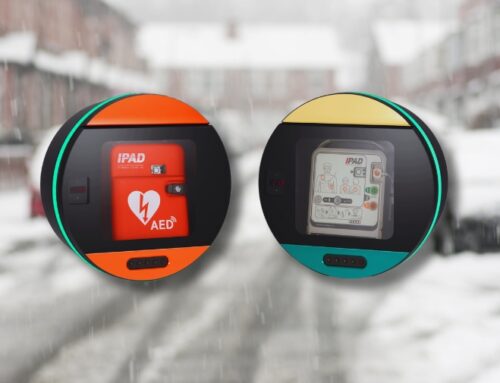[vc_row][vc_column][vc_column_text]A defibrillator is a vital piece of lifesaving equipment that can be used by anyone. However, we often hear a number of assumptions about them that range from understandable but incorrect, to somewhat silly, to downright dangerously wrong.
We believe everyone should have full access to a defibrillator when they need one, and be armed with accurate, up to date information about what an AED (automated external defibrillator) is, and how to use one.
To that end, we put together this blog post on the most common defibrillator myths debunked. Or, as we like to think of it: ‘Myth vs Fact – AED Edition.’
Do all defibrillators have hand-held paddles?
We’ll start with one of the most common defibrillator myths to be busted – and one we blame TV and movies for. Because no, unlike what you see on the big or small screen, modern automated external defibrillators don’t come with two handheld paddles you need to place on the casualty’s chest.
There’s also no yelling “clear!” or the patient’s body spasming uncontrollably upwards when a shock is administered. AEDs like the iPAD SP1 come instead with two electrode pads, and the unit itself will scan a person’s prone body before delivering the shock itself (unless manual mode is engaged, in which case you press a button). When the shock happens, their body will simply silently stiffen up.
There are admittedly defibrillators with paddles, but they tend to be larger and used inside hospitals. For the most part, the typical defibrillator you’ll find in public spaces or carried by paramedics is a more low-key, less dramatic, but still no less vital piece of equipment, than the one seen in your favourite medical drama.
Do you place both defibrillator pads side by side on the patient’s chest?
[/vc_column_text][vc_empty_space height=”16px”][vc_single_image image=”2412″ img_size=”full”][/vc_column][/vc_row][vc_row][vc_column][vc_empty_space height=”36px”][vc_column_text]This is, for the most part, a myth. While that might be the case for the paddles on a hospital-based defibrillator, AED pads should be placed with one on the top right of a patient’s chest above the nipple and below the collarbone, while the other should be placed further on the lower left of the chest. Fortunately, most AED pads have pictures printed on them to show you where they should be placed. That’s another of the most common AED myths debunked.
Could you make things worse if you defibrillate someone?
Absolutely not.
During a sudden cardiac arrest, every minute that goes by without both CPR and defibrillation sees the casualty lose 10% chance of survival. So if you see someone suddenly collapse with no visible sign of life, then deciding to defibrillate isn’t just the brave choice – it’s the only choice.
On top of this, if you aren’t sure whether they should be defibrillated or not – the AED itself will be. If you hook up the electrodes and the unit finds they don’t have a shockable heart rhythm, it simply won’t shock them. You cannot make things worse by defibrillating. But you can make them better – by saving someone’s life.
Can using a defibrillator near water cause electrocution?
Another no.
It’s true that electricity and water don’t mix – so we would always advise moving a casualty away from bodies of water like puddles, pools, lakes or the sea. We’d also suggest removing wet clothes, and drying their skin so that the electrodes can stick in place and work properly.
That being said, defibrillators will not cause electrocution, even if the casualty’s body isn’t bone dry. They simply aren’t designed that way.
And with that, another one of the most common defibrillator myths is debunked![/vc_column_text][vc_empty_space height=”16px”][vc_row_inner][vc_column_inner][vc_column_text]
Are defibrillators used to treat heart attacks?
[/vc_column_text][/vc_column_inner][/vc_row_inner][vc_empty_space height=”16px”][vc_single_image image=”2417″ img_size=”full”][vc_empty_space height=”16px”][/vc_column][/vc_row][vc_row][vc_column][vc_column_text]We’ve explained this one in both our blog on what happens when you use a defibrillator, and at length in our piece for World Heart Day: Heart Attack or Cardiac Arrest. But in short – no, that’s a common misunderstanding about the differences between a heart attack and a cardiac arrest.
A heart attack happens when an artery becomes blocked and the heart gets starved of blood, causing that part of the heart to start to die.
A cardiac arrest happens when the heart’s natural pumping rhythm becomes erratic due to a change in electrical signals sent to the heart’s natural pacemaker, the sinoatrial node. This causes the heart to spasm or flutter instead of beating rhythmically – a phenomenon called ventricular fibrillation.
A defibrillator, as the name suggests, is designed to undo ventricular fibrillation by shocking the sinoatrial node into resetting to its default pumping rhythm.
As such, a defibrillator will not restart a heart that has already flatlined. It will, however, help reset/restart a heart in ventricular fibrillation that has a shockable rhythm. When it comes to the myths and truths of defibrillators, this is perhaps one of the most important distinctions to make.
Will a defibrillator always restart someone’s heart if it hasn’t flatlined?
Alas, sadly the answer to this is also no. Were it true, there would undoubtedly be many more defibrillators in public spaces than there are!
However, as mentioned above, every minute that passes without treatment during a sudden cardiac arrest erodes 10% of a person’s chances of survival. By reacting promptly and performing both CPR and defibrillation, there is an excellent chance of saving someone’s life.
Do you need lots of in-depth training to use a defibrillator?
[/vc_column_text][/vc_column][/vc_row][vc_row][vc_column][vc_empty_space][vc_single_image image=”2411″ img_size=”full” alignment=”center”][vc_empty_space][/vc_column][/vc_row][vc_row][vc_column][vc_column_text]Thankfully, you do not!
While we at WEL Medical offer a simple CPR and defibrillation training workshop to anyone taking one or more of our units, AEDs in general don’t require any in-depth specialist knowledge to operate. In fact, most (including our best-selling iPAD SP1) have a combination of illustrations on the front with lights that appear next to them, and voice guidance, that together prompt the user on what to do at every stage of use.
So, while it is better to be fully trained (and being so is likely to help you respond quicker in a crisis), specialist training isn’t essential.
That’s yet another of the most common defibrillator myths busted, and with it, another blocker to owning an AED removed.
Are defibrillators mandatory in UK workplaces?
Unfortunately, they aren’t – though we’re big believers in the idea that they should be.
At present, the Health and Safety Executive website says:
“It is not compulsory for employers to purchase AEDs to comply with the Health and Safety (First-Aid) regulations 1981. However, if your needs assessment identifies an AED need then we recommend your staff should be fully trained in its use.”
We always recommend that businesses of all types and sizes conduct a thorough needs assessment and make room in their budget and property for an automated external defibrillator. It might sound dramatic, but doing so really could be the difference between life and death.
Are you considering getting a defibrillator?
At WEL Medical, we believe all high footfall areas should certainly house a defibrillator close by – and we stock a range of different solutions for different budgets.
Visit our AED shop here, or contact us and we’ll talk you through the different options available.
Related articles
- What Happens When You Use A Defibrillator?
- World Heart Day: Heart Attack or Cardiac Arrest?
- World First Aid Day: CPR Guidance in a Covid-19 World
- Places You Wouldn’t Think Need a Defib (But Really Do!)
- Soccer Shock: Why Football Needs Defibrillators at Every Level
- WEL Medical and Premier League Team Up for Lifesaving Grassroots Defibrillation Deal
[/vc_column_text][/vc_column][/vc_row]





